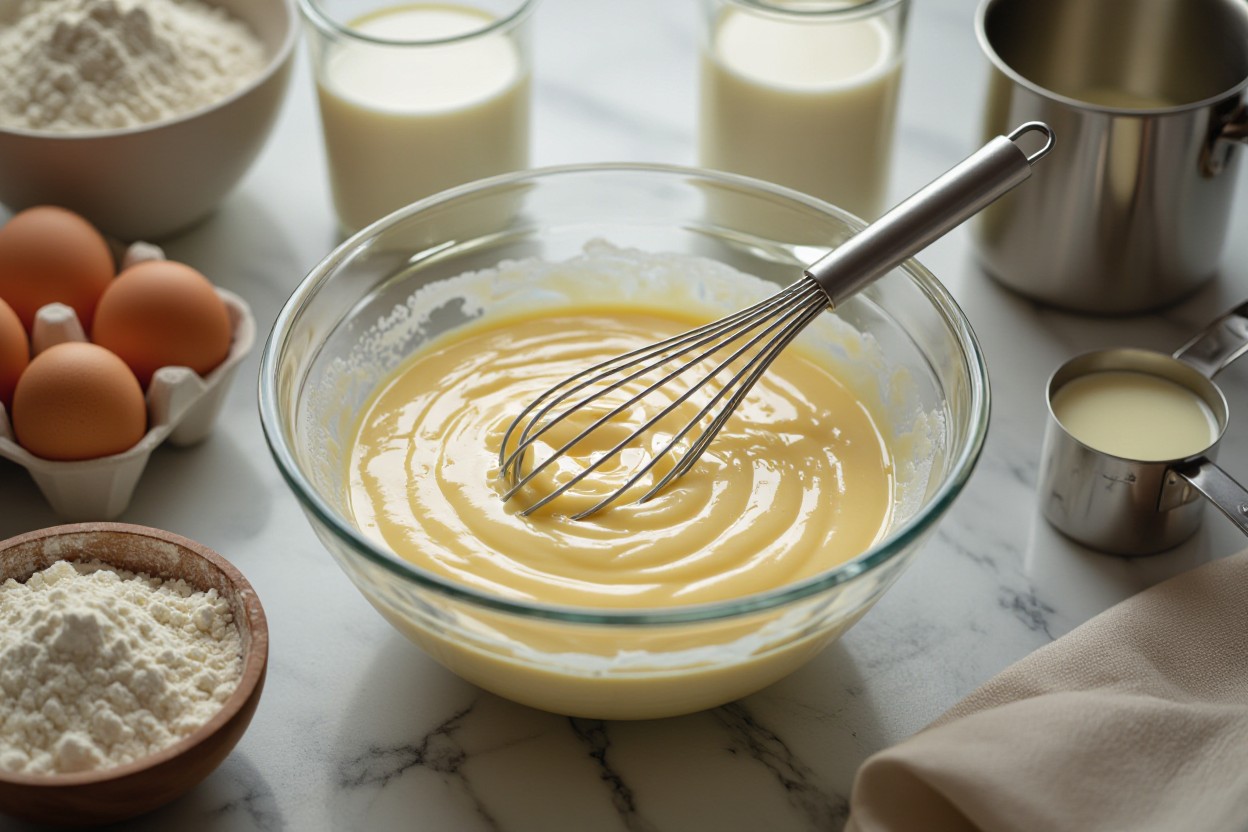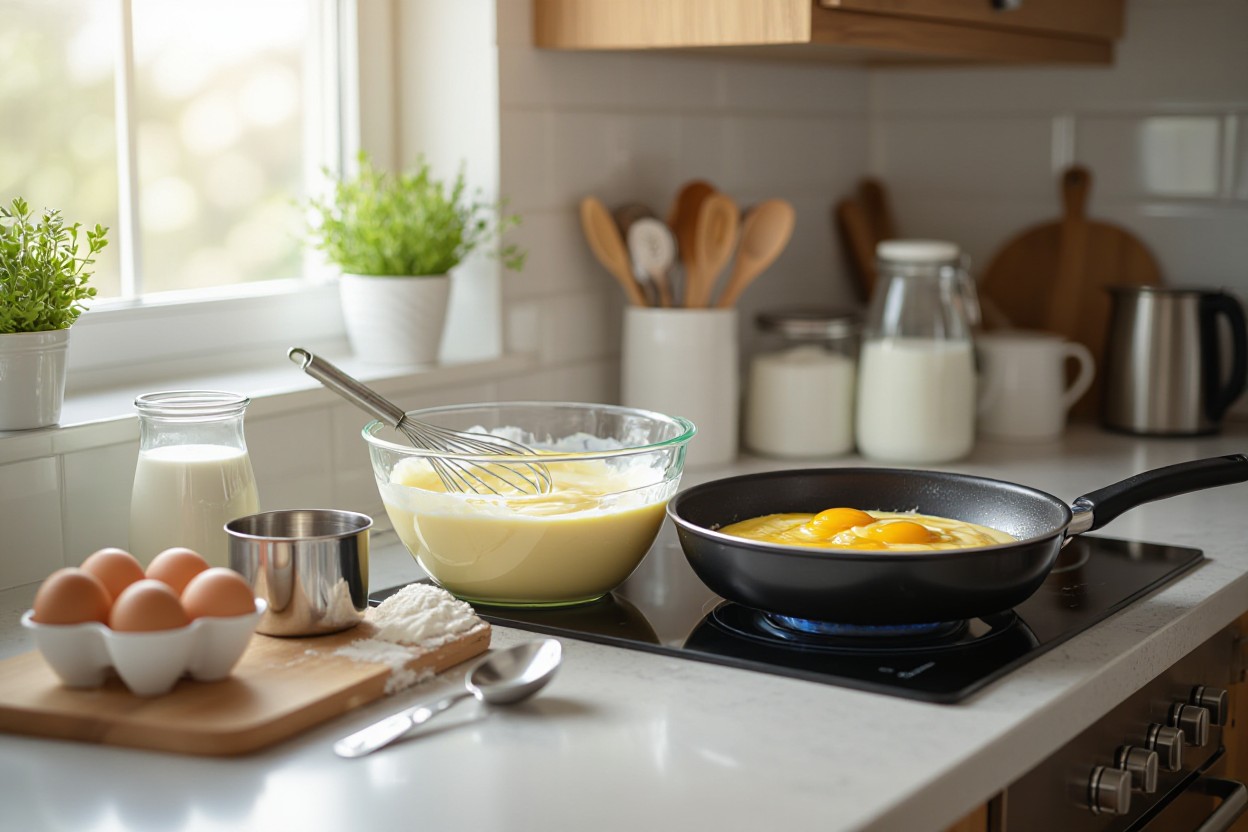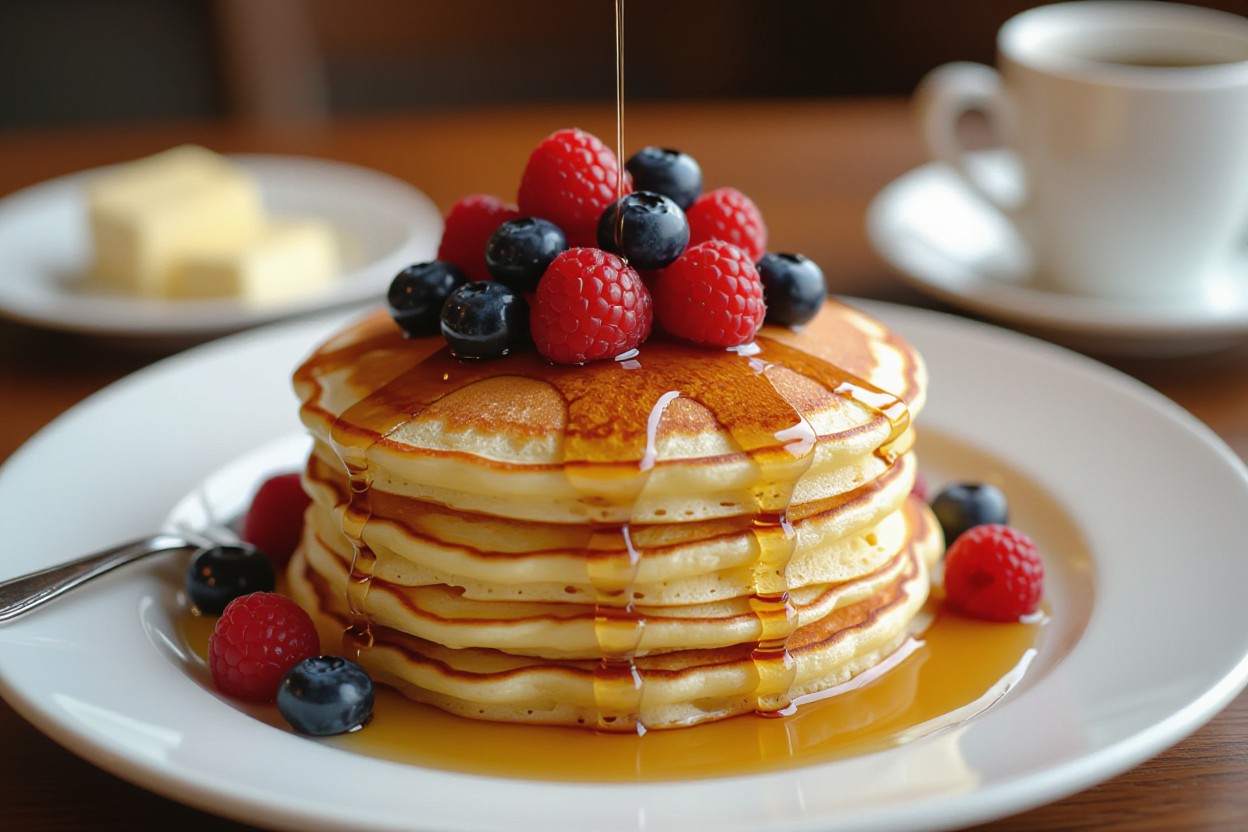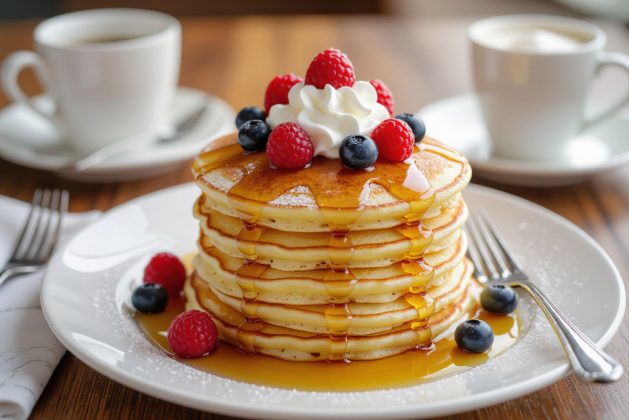The Science of Fluffy Pancakes
Understanding how leavening agents like baking powder and baking soda react with acidic components in your batter explains why your pancakes rise beautifully. I rely on the precise balance of these ingredients—too much and the batter collapses, too little and your pancakes turn dense. The protein structure formed by eggs and gluten traps air bubbles created during mixing, while gentle handling prevents overdeveloping gluten, which would toughen the texture. Temperature also plays its role: cooking on medium heat ensures the batter cooks evenly without burning, allowing those airy pockets to set into the soft, fluffy interior you desire.
Essential Ingredients for the Perfect Batter
The foundation of fluffy pancakes lies in the careful selection of ingredients. Each component plays a specific role, from texture to flavor, ensuring your batter achieves that coveted lightness and rise. The balance between dry and wet elements, along with proper leavening, determines how well your pancakes will fluff up. I always pay particular attention to quality and freshness, especially when it comes to flour and eggs, as they significantly influence the final outcome.
Choosing the Right Flour
Flour type impacts the pancake’s texture and structure; all-purpose flour works well, but shifting to cake flour can yield even softer, more tender pancakes due to its lower protein content. Using whole wheat flour adds a nuttier flavor but can make pancakes denser if not balanced with lighter flours. Sifting the flour beforehand helps aerate it, contributing to a lighter batter, which supports fluffiness as the pancakes cook.
The Role of Leavening Agents
Baking powder and baking soda introduce gas bubbles that expand during cooking, directly affecting fluffiness. Baking powder, a double-acting leavening agent, triggers two rises—once when moistened and again under heat—ensuring consistent lift. Baking soda requires acid to activate, like buttermilk or yogurt, producing carbon dioxide that puffs the batter. Proper measurement is vital; too much can leave a bitter aftertaste, while too little results in flat pancakes.
Beyond just rising, leavening agents contribute delicate air pockets that give pancakes their signature light texture. Combining baking powder with an acidic ingredient like lemon juice or vinegar can intensify this effect. For instance, using buttermilk with baking soda not only activates the leavening but tenderizes the batter through its acidity, enhancing flavor and softness simultaneously. Experimenting with ratios can help you tailor the rise and crumb to your preference.
Milk and Eggs: The Key to Texture
Milk hydrates dry ingredients and contributes to batter consistency; whole milk offers richer flavor, while buttermilk adds tang and acidity that work synergistically with leavening agents. Eggs bind ingredients and add moisture and fat, giving structure and tenderness. Using fresh eggs and striking the right balance ensures pancakes stay lofty without becoming rubbery or dense.
The protein and fat content in eggs directly influence tenderness and fluffiness. Whipping egg whites separately before folding them into the batter can amplify lift by trapping more air. Meanwhile, milk’s fat content enriches the batter, improving mouthfeel and browning. Substituting part of the milk with cultured dairy like kefir can introduce acidity and gentle enzymes that break down gluten, further enhancing softness and flavor depth in your pancakes.

Mastering the Mixing Technique
The art of mixing pancake batter lies in balancing the ingredients without overworking them. A gentle fold rather than vigorous stirring keeps the batter light, allowing air bubbles to remain trapped. These bubbles create the fluffiness that defines a perfect pancake. As you mix, tiny pockets of air expand during cooking, resulting in unmatched texture. Using a large bowl makes it easier to fold ingredients without new lumps forming. My strategy involves mixing just until the flour streaks disappear, ensuring the batter isn’t overly dense. This approach guarantees consistently fluffy pancakes that delight every time.
The Importance of Measurement
Proper measurement of ingredients safeguards the texture and rise of your pancakes. Using a kitchen scale increases precision compared to cups, especially for flour, which can vary greatly when scooped. A difference of even five grams in baking powder can alter the batter’s lift and density. Liquid ingredients like milk and eggs also require accurate amounts to maintain the balance between wet and dry. I weigh the flour and baking powder daily to make sure my pancakes turn out consistently airy. The key is meticulousness in every ingredient’s quantity to perfect the pancake batter structure.
How to Combine Ingredients Without Overmixing
Incorporating dry and wet ingredients gently preserves the integrity of gluten strands and trapped air. Use a silicone spatula to fold the batter by scraping the bowl’s edges toward the center in a circular motion. Scour the batter slightly stiff but still lumpy; do not strive for total smoothness, as this indicates overmixing. Small lumps dissolve during cooking, while overworked batter develops a dense, gluey texture. I always pause mixing once most dry pockets are melded, then rest the batter briefly before cooking, aiding gluten relaxation and aeration. This technique distinctly enhances your pancakes’ fluffiness.
The science behind folding rather than stirring is that excessive mixing creates too much gluten, making pancakes chewy rather than soft. Allowing some lumps to remain means the batter retains air bubbles and develops a tender crumb once heated. I rely on a spatula’s flexibility and slow, controlled motions to blend ingredients, preventing the batter from becoming tough. The rest period lets bubbles stabilize internally, reinforcing your pancakes’ rise and fluff. Mastering this step distinguishes homemade pancakes with a texture far superior to rushed mixes.
Tips for Adding Flavor Enhancers
Incorporating flavor enhancers transforms basic pancakes into memorable treats. Vanilla extract, a vanilla bean paste, or almond extract add depth without overpowering. Cinnamon pairs beautifully with fruit additions like blueberries or bananas. I add a pinch of salt to balance sweetness and awaken flavors fully. When mixing in zest like lemon or orange, do so gently to avoid bitterness. Ingredients like brown sugar or honey replace standard sugar for a rich, caramel-like complexity. Combining these subtle enhancements in measured ways amplifies your pancake flavor profile creatively and deliciously.
- Vanilla extract adds aromatic warmth
- Cinnamon complements fruity notes brilliantly
- Salt balances sweetness for full flavor
- Brown sugar lends a caramel undertone
- Citrus zest introduces fresh brightness
Balancing flavor enhancers means you keep your pancakes appealingly nuanced rather than overwhelming the palate. I experiment with small amounts to find the right harmony that boosts the batter without masking its core buttery taste. Natural extracts and spices activate taste buds and invite variety without complicating the recipe. Perceiving these subtle flavor shifts helps you customize pancakes for every occasion, striking the perfect balance between traditional and inventive.
- Personalized flavor adjustments suit any breakfast mood
- Small quantities avoid overpowering the batter’s natural taste
- Experimentation refines your signature pancake style
- Quality extracts make a noticeable difference
- Balancing spices and sweetness enhances overall enjoyment

Crafting the Ideal Cooking Environment
Getting pancakes just right depends heavily on your cooking setup. Adjusting stove heat, selecting suitable cookware, and mastering timing all contribute to pancake fluffiness and even cooking. I’ve found that maintaining a consistent, moderate heat prevents burning or undercooked spots. Using a surface that distributes heat evenly ensures every pancake cooks uniformly. Additionally, flipping at the right moment preserves the air bubbles responsible for fluffiness. Your kitchen environment, while often overlooked, is as important as the batter itself in achieving perfect pancakes.
Heat Control: Achieving the Perfect Temperature
| Heat Level | Effect on Pancakes |
|---|---|
| Low (Warm Setting) | Slow cooking, resulting in flat, dense pancakes |
| Medium (350°F / 175°C) | Optimal balance for golden color and even cooking |
| High (Above 375°F / 190°C) | Burnt exterior, raw interior, uneven rise |
Setting your skillet to about 350°F allows batter to bubble and rise steadily without charring. Use an infrared thermometer to check surface temperature or perform the classic water droplet test: droplets should dance and evaporate quickly but not instantly burn. Heating too high runs the risk of tough pancakes; too low keeps them pale and gummy.
Choosing the Right Cookware
Nonstick pans or well-seasoned cast iron skillets work best for pancakes. They provide even heat distribution and require less oil, which helps develop even browning without sticking. I prefer cast iron because it retains steady heat well, preventing hot spots that cause uneven cooking. Avoid thin stainless steel pans, which can cause rapid, uneven heating. Using a pan with a diameter of around 10 inches provides enough surface area for 3-4 pancakes at once, speeding breakfast preparation while maintaining control over heat.
Cast iron’s advantage is in its thermal mass—it stays warm after adding batter, allowing consistent cooking from start to finish. Nonstick pans require less maintenance and cleanup, making them ideal for quick weeknight breakfasts. Whichever you choose, ensure the bottom of the pan is flat and clean to optimize contact with the heat source.
Timing and Flipping: The Art of Pancake Cooking
Time the flip to when small bubbles form on the batter’s surface and edges look set but not dry. This typically happens around 2-3 minutes per side at medium heat. Flip gently using a thin spatula to avoid deflating the pancake. Flipping too early collapses the air pockets; too late leads to dark, crispy edges.
As you practice, watch for these visual cues: bubbles forming and popping evenly, edges turning firm and opaque, and a slight lift when sliding the spatula under the pancake. Each flip should be deliberate but confident. After flipping, cook the other side for about half the initial time to ensure the pancake is golden and cooked through without becoming tough. Timing precision greatly enhances the fluffy texture and consistent appearance.

Elevating Your Breakfast Experience
Transforming your fluffy pancakes into a memorable meal means exploring beyond the basic batter. By experimenting with textures, flavors, and colors, you can easily turn a simple breakfast into a feast that delights the senses. Whether through toppings, syrups, or even creative side dishes, there’s always a way to add an exciting twist. I find that these little enhancements not only elevate the flavor but also make the overall breakfast experience more enjoyable and visually appealing.
Creative Toppings and Add-Ins
Incorporating fresh fruits like blueberries, sliced bananas, or strawberries adds vibrant color and natural sweetness. You could also sprinkle nuts such as toasted pecans or walnuts for an irresistible crunch. For a more decadent touch, dollop on whipped cream or drizzle melted chocolate. Seasonal spices like cinnamon or nutmeg stirred into the batter or sprinkled on top offer warmth and depth, making each bite a perfect balance of flavors.
Pairing with Syrups and Sides
Maple syrup remains the classic choice, but don’t shy away from alternatives like honey, berry compote, or even caramel sauce. For a savory twist, try topping your stack with crispy bacon or sausage links alongside your pancakes. Yogurt or cottage cheese on the side not only adds creaminess but also a protein boost. This combination enhances both taste and nutritional balance, making your breakfast more satisfying.
The variety of syrups and sides you choose can dramatically influence the flavor profile of your pancakes. A homemade berry compote introduces tartness that contrasts beautifully with the fluffy softness, while a drizzle of rich caramel syrup adds indulgence. Pairing with protein-rich sides like eggs or smoked salmon can balance the sweetness with savoriness. I like to mix and match until I find a combination that feels both indulgent and nourishing, giving new life to the traditional pancake breakfast.
Presentation Tips for a Stunning Meal
Stack your pancakes neatly to showcase their height and fluffiness. Use garnishes like a sprig of mint, a dusting of powdered sugar, or a few whole berries for a pop of color. Serve on pretty plates with complementary napkins or placemats that highlight your meal’s inviting look. Drizzle syrups artistically rather than pouring them straight on to create visual interest and appeal.
A beautifully presented pancake plate turns an ordinary breakfast into an experience worth savoring. Layering pancakes evenly helps emphasize their fluffy texture, while thoughtful placement of toppings and sides keeps the plate balanced and eye-catching. Using simple tools such as a sieve for powdered sugar or a spoon for syrup drizzle can elevate your plating without extra effort. Here is what I suggest focusing on for presentation:
- Neat pancake stacks to emphasize height and fluffiness
- Colorful garnishes like berries and mint for visual contrast
- Artful syrup drizzling to avoid a messy look
- Proper plate choice to complement the food colors
After mastering these presentation tips, your pancakes won’t just taste perfect—they’ll invite compliments before the first bite.
To wrap up
Taking this into account, I encourage you to follow these steps carefully to make fluffy pancakes that will impress your family and friends every time. By using fresh ingredients, mixing the batter just enough, and cooking on a properly heated griddle, you can achieve the perfect texture and flavor. Your breakfast will transform into a delightful experience, and with practice, you’ll confidently create pancakes that are light, airy, and delicious. Trust in this method, and enjoy the process of making and sharing the ultimate breakfast treat.





Leave a comment